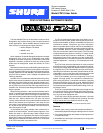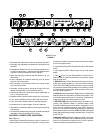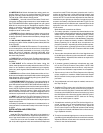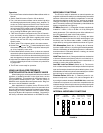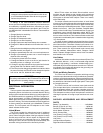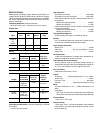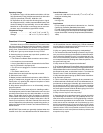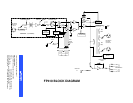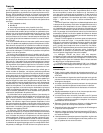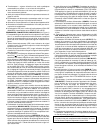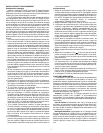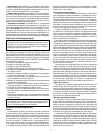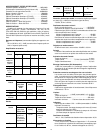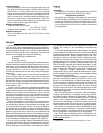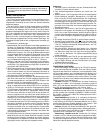
7
Operating Voltage
AC Operation: 100 to 120 Vac rated nominal, 80 to 132 Vac
fullyoperational(FP410);230Vacratednominal,160to264
Vac fully operational (FP410E), 50/60 Hz, 8 W
DC Operation: 18 Vdc nominal at 25 mA typical no--signal,
33mAtypicalat0VU(+4dBm)outputwith600
τload;6Vdc
minimum; battery life approximately 12 hours with alkaline
batteries at +4 dBm output in continuous use at room tem-
perature; two 9--volt batteries (type NEDA 1604A)
Temperature Range
Operating --18
to 57 C(0 to 135 F).............
Storage --29
to 71 C(--20 to 160 F)...............
Overall Dimensions
44.5 mm H x 368 mm W x 210 mm D (1
3
/
4
x14
1
/
2
x8
1
/
4
in-
ches)(not including feet)
Net Weight
2.27 kg (5 lb)
Certifications
FP410: Listed by Underwriters Laboratories, Inc., listed as
Certified by Canadian Standards Association.
FP410E:ConformstoEuropeanUniondirectives,eligibleto
bearCEmarking;VDEGS-certifiedto EN60065;meetsEu-
ropean Union EMC Immunity Requirements (EN 50 082-1,
1992).
Questions &Answers
Questions about your FP410installation? This sectionlists
the most common questions asked about Shure’s automatic
microphone systems. Maybe your question is among the fol-
lowing. If not, contact Shure’s Customer Service Department.
Q. Why don’t I get any sound output from my FP410?
A. Assuming that your power amp, tape deck, speakers, etc.
are good, possibly it’s because:
The Channel or Master Gain controls are turned down,
A microphone is not connected,
A rear--panel Mic/Line input or output switch or thePhan-
tom On--Off switch is improperly set,
The FP410 isn’t plugged in or doesn’t have batteries in-
stalled, or
The Power switch isn’t on.
Check these items and make the required c orrection.
Q. Still doesn’t work. Why?
A.Maybeyou havea defectivemicrophoneorcable. Whilelis -
tening to headphones plugged into one of the front--panel
Phone jacks, try replacing the suspect microphone or cable
with one known to be good.
Q. Why does a microphone turn on or off erratically, causing
speech dropouts?
A. Excessiveroomnoise (suchas fromair--handling oraudio--
visualequipment)canbe acause.Reducetheroomnoise,the
proximity ofthe noise toany mic, and/orthe talker--to--micdis -
tance. A loud talker close to their microphone or with their
Channel Gaincontrol set too highcan sometimesinhibit prop-
er microphone activation by a “weaker” talker who is too far
from their microphone or has their Channel Gain control set
too low. Balance the microphones by repositioning and/or re-
setting the Channel Gain controls in accordance with the Op-
eration section.
IMPORTANT: Best results are generally obtained when the
Last Mic Lock--On is not defeated and the Off--Attenuation is
13 dB (modifiable function switches up). Difficult situations
may be aided by changing the Hold Time from 0.4 to 1.0 sec-
ond (modifiable function switch down).
Q. Why am I getting howling through my loudspeakers?
A. For the same reason that howling is present in any PA sys-
tem: yourmics are picking up the speaker sound andreampli-
fying it. Move thes peakers or mics, orturn down the gain con-
trols, to avoid the howling. Automatic operation does provide
more output level before howling than manual operation, but
the system still can howl.
Q. Why does the FP410 output sound distorted?
A.TheChannel,MasterorPhones Gaincontrol maybesettoo
high.SettheChannelGainaccordingtotheOperationsection.
Setthe MasterGainto avoidexcessivered LEDindicationson
the OutputLevel meter,or switch theLimiter in. Turndown the
Phones control. Check the following equipment levels.
Q.Why does thespeech levelgo up when Iswitch fromManu-
al to Automatic operation?
A. This is normal and proper operation for any automatic mix-
er.When switched to Automatic, the FP410 attenuates any in-
put channel not being used. Internally, this removes the inac-
tive channels from the FP410 mix bus. This action increases
the perceived level of any active input channel. For example,
the audio gain increase will be 6 dB when going from four to
only one activated microphone channel.
Q. Why is one of my four mics very noisy?
A. Assuming the mic is operating properly (you can checkthis
by substituting with another mic), you probably have a con-
stant noise source such as air--moving equipment or a defec-
tive fluorescent light ballast in the trouble area. This ambient
noise source can be unnoticed until it’s picked up by a mic:
thenit’sextremelyannoying.Ifyoucan’trepair,turnofforlower
the noise source, try relocating themic to eliminate or at least
lower the noise. If this is not possible, use the FP410 in the
Manual mode to avoid microphone activation problems and
accept the noisy output.



